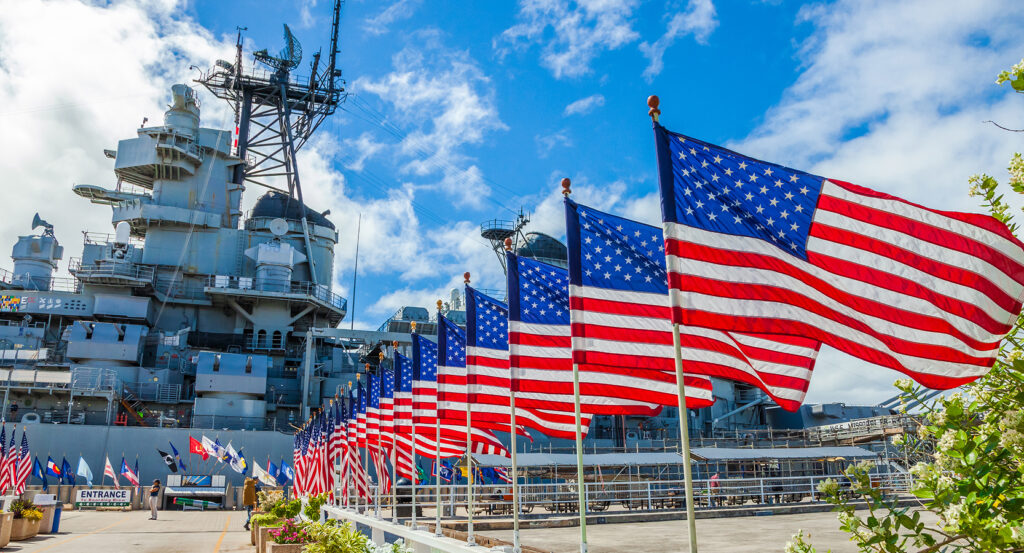
Why you should experience Pearl Harbor National Memorial in Honolulu.
The Pearl Harbor National Memorial isn’t just a monument, it’s a moment suspended in time, where the calm waters of Oʻahu cradle both immense loss and enduring courage.
Located along the southern shores of Honolulu, the memorial stands as one of the most powerful and poignant places in the United States, a sanctuary of remembrance that feels both vast and intimate. The harbor, once torn apart by chaos, now rests in almost supernatural stillness. Palm trees sway softly in the wind, their shadows stretching over the water as sunlight dances across the surface. The faint scent of salt and plumeria mingles with the sound of waves lapping against the shore, but beneath that peace lies history’s echo, the morning of December 7, 1941, when the world changed forever. Looking out across the harbor, the contrast feels almost surreal: the beauty of paradise holding the weight of tragedy. The white marble curves of the USS Arizona Memorial gleam against the blue, its reflection trembling on the surface like memory itself. Inside, the air is still, heavy, sacred. You can see the rusted hull of the sunken battleship below, a silent grave for over a thousand souls who never left their posts. Oil still rises from the wreckage in slow, shimmering drops, forming rainbows across the surface, “black tears,” as survivors call them. The experience is quiet but overwhelming; Pearl Harbor National Memorial isn’t a place you merely visit, it’s one you feel.
What you didn’t know about Pearl Harbor National Memorial.
What makes the Pearl Harbor National Memorial so extraordinary is the depth of meaning layered within every inch of its design and history, a place where remembrance becomes architecture, and grief transforms into grace.
The memorial was dedicated in 1962, designed by Austrian-born architect Alfred Preis, who himself had been detained as an enemy alien during World War II before later becoming an American citizen. His design is profoundly symbolic: the structure’s sagging center represents the low point of America’s defeat, while its upward arches at either end signify hope and ultimate victory. The USS Arizona below remains undisturbed, resting exactly where it sank on that fateful morning, its decks sealed by time and coral. The names of all 1,177 sailors and Marines who perished aboard are etched into the marble wall within the shrine room, a space that feels more like a cathedral than a monument. Yet the National Memorial encompasses much more than the Arizona. Together with the USS Utah and USS Oklahoma memorials and the visitor center exhibits, it forms the core of a greater network of remembrance known as the Pearl Harbor Historic Sites. These include the USS Missouri, where Japan officially surrendered in 1945, and the Pearl Harbor Aviation Museum, which tells the story of the Pacific theater through the lens of flight and innovation. The National Park Service, which oversees the site, works closely with survivors, descendants, and the U.S. Navy to preserve both the physical remains and the human stories tied to the harbor. Few know that the memorial itself was built over the water, anchored into the sunken Arizona without ever touching it, to ensure that the final resting place of those who died remains undisturbed. This delicate balance of reverence and restraint defines the site’s spirit. It’s not about victory or vengeance; it’s about remembrance, reflection, and the enduring cost of peace.
How to fold the Pearl Harbor National Memorial into your trip.
To experience the Pearl Harbor National Memorial properly, come with time, patience, and an open heart, because this isn’t a destination to rush through, but one to absorb deeply.
Begin at the Pearl Harbor Visitor Center, where exhibits and films provide the historical context that turns dates and numbers into human stories. The displays are thoughtful and deeply moving, chronicling not just the attack but the lives that shaped it, stories of sailors writing letters home, of nurses treating the wounded, of civilians awakening to a world at war. From there, board the Navy-operated shuttle boat that carries visitors across the harbor to the USS Arizona Memorial. The ride is silent but powerful, seagulls arc overhead, and the reflection of the mountains glimmers in the water. Stepping inside the memorial, pause at the open windows where sunlight and sea breeze flow freely through the structure. The silence here feels absolute; even the wind seems to move with reverence. Take time to read the names carved into the wall, to look down at the shadow of the battleship beneath the waves, and to feel the weight of that stillness. Afterward, visit the USS Missouri on Ford Island, the “Mighty Mo,” where World War II officially ended. Standing on its polished decks, you can almost sense the connection between these two vessels: one marking the beginning of the war, the other its conclusion. Before leaving, explore the Pearl Harbor Aviation Museum nearby, housed in the original hangars that still bear bullet holes from the attack. As the day draws to a close, step outside to the edge of the harbor. The water glows gold in the fading light, the memorial gleaming white in the distance, a vision of peace rising from the memory of war. The Pearl Harbor National Memorial isn’t just a landmark, it’s a living promise that remembrance will never fade. Standing there, surrounded by beauty and silence, you realize the harbor’s calm isn’t emptiness; it’s grace, a reminder that even the darkest moments of history can give rise to light, understanding, and unity.
Hear it from the Foresyte community.
Walk in and it’s quiet in a way that doesn’t feel forced. You just look around and know this spot means more than your own plans for the day.
Where meaningful travel begins.
Start your journey with Foresyte, where the planning is part of the magic.
Discover the experiences that matter most.












































































































